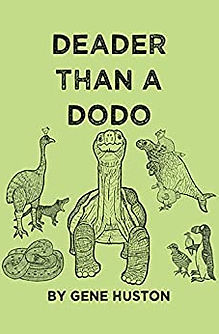THE MISSION
The purpose of this website is to teach others about extinct animals. As a father of three and a 4th/5th grade teacher for 20+ years, I know that some people love reading nonfiction. If that is you, enjoy the information located under the 'EXTINCT SPECIES tab. If you like learning through fiction, you can read The Lazarus Tales under the LAZARUS TALES section of each species or you may enjoy reading my fictional book listed under the DEADER THAN A DODO BOOK tab. I always hope to teach others to enjoy researching and learning about new things. My goal with my own kids and my students is to give them information and let them process it and ask questions without me giving them the scripted, cookie cutter answers. Often the best questions have no easy, straight forward answers. Many extinct animal stories show this very thing.
THE BOOK
THE JOURNEY
My love of extinct animals began in 6th grade when I did a research paper on the ivory billed woodpecker, which may or may not be extinct. It instilled a passion in me to understand why and how so many different animals went extinct in our recorded past. Their individual stories of extinction are amazing, and I wanted to share them with others. Some animals went extinct due to poor planning on the part of people. Others like the heath hen, the passenger pigeon, and the thylacine people tried in vain to save from extinction. It was too little, too late. These extinction stories have helped us make better choices concerning animals that are struggling to survive today. Even when I visit zoos today, I am most amazed by the animals which are critically endangered, the ones which my children and grandchildren may never get to see. I would wonder what they would say if they could speak. Do they hold a grudge about their current situation? Do they like their life at the zoo? What would they say to us, if they could speak? I didn’t know about Lonesome George until a fourth-grader I was teaching started crying in the computer lab. I had no idea why, since my students were supposed to be selecting an animal to research. Most students had selected a panda or cheetah, the usual, but not this particular student. When I asked her why she was crying, she said that the Pinta Island tortoise was going to be extinct. There was no hope in saving the real Lonesome George from extinction. This student was crying because she felt devastated by the death of that tortoise and his entire species. It was that day in the computer lab that I realized how much certain animals mean to certain people. I felt a greater desire to teach future generations about George, and other lesser-known endangered species, as well as some of the fascinating stories of extinction in recent times. Even as I was writing this book and gathering information for it, my daughter asked about some of the animals. I explained to her that some animals like dinosaurs went extinct millions of years ago, while some animals went extinct because of people. She asked me what being extinct meant. I explained it meant there are no more of a certain kind of animal, like the dodo, so we can never see a real one in the wild or in a zoo. She started screaming that she wanted to see a dodo. Her youthful passion solidified for me the importance of sharing these animals' stories with future generations. I knew I wanted ‘Lonesome George’ to lead my ragtag bunch of extinct animals on their mission to save the world. Then it was my turn to be saddened by George because a few months into writing this book, while looking up George’s weight, I discovered that the real Lonesome George had died much sooner than scientists at the Charles Darwin Research Station had expected. This affected my book idea, but it did give me the ability to have him identify his own extinction date, June 24, 2012. I have tried my best to keep the facts about each animal as true as possible. I have taken some liberties with some ‘gray areas’ in extinct animal debates, such as whether the quagga is simply a plains zebra or whether the heath hen is really a subspecies of the lesser prairie chicken. I hope George’s mission inspires thought-provoking conversations about the stories represented throughout this fictional adventure.






